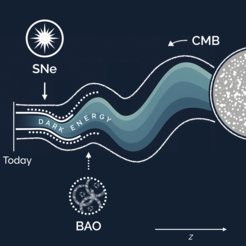A model-independent reconstruction of dark energy through the Universe’s history
Research team presents a new approach to testing the nature of dark energy
Understanding whether dark energy evolves over time is one of the key challenges in today's cosmology. Recent results from the Dark Energy Spectroscopic Instrument (DESI) clearly suggest a preference in the data for a time evolution that departs from a simple cosmological constant contribution. But how can scientists study the problem by letting the data speak for themselves, without imposing the bias of their favourite cosmological model? Model-independent reconstruction methods offer a way to allow observations to directly guide constraints on the evolution of the dark energy density. This approach opens a path to testing the nature of dark energy with minimal theoretical assumptions. Like model-based studies, this agnostic reconstruction presented in a new study finds a significant deviation from a cosmological constant. The analysis reveals hints of complex evolution throughout cosmic history, with a density that at times increases as the universe expands. If confirmed by future data, this trend disfavours simple theories, including new fields without exotic gravitational interactions. A revision of Einstein’s theory on cosmological scales may then become necessary.
Paper abstract

In light of the evidence for dynamical dark energy (DE) found from the most recent Dark Energy Spectroscopic Instrument (DESI) baryon acoustic oscillation (BAO) measurements, we perform a nonparametric, model-independent reconstruction of the DE density evolution. To do so, we develop and validate a new framework that reconstructs the DE density through a third-degree piecewise polynomial interpolation, allowing for direct constraints on its redshift evolution without assuming any specific functional form. The strength of our approach resides in the choice of directly reconstructing the DE density, which provides a more straightforward relation to the distances measured by BAO than the equation of state parameter. We investigate the constraining power of cosmic microwave background (CMB) observations combined with supernovae (SNe) and BAO measurements. In agreement with results from other works, we find a preference for deviations from Λ CDM, with a significance of 2.4𝜎 when using the Dark Energy Survey Year 5 (DESY5) SNe data, and 1.3𝜎 with PantheonPlus. In all the cases we consider, the derived DE equation of state parameter presents evidence for phantom crossing. By investigating potential systematic effects in the low-redshift samples of DESY5 observations, we confirm that correcting for the offset in apparent magnitude with respect to PantheonPlus data, as suggested in previous studies, completely removes the tension. Furthermore, we assess the risk of potentially overfitting the data by changing the number of interpolation nodes. As expected, we find that with lesser nodes we get a smoother reconstructed behavior of the DE density, although with similar overall features. The pipeline developed in this work is ready to be used with future high-precision data to further investigate the evidence for a nonstandard background evolution.
